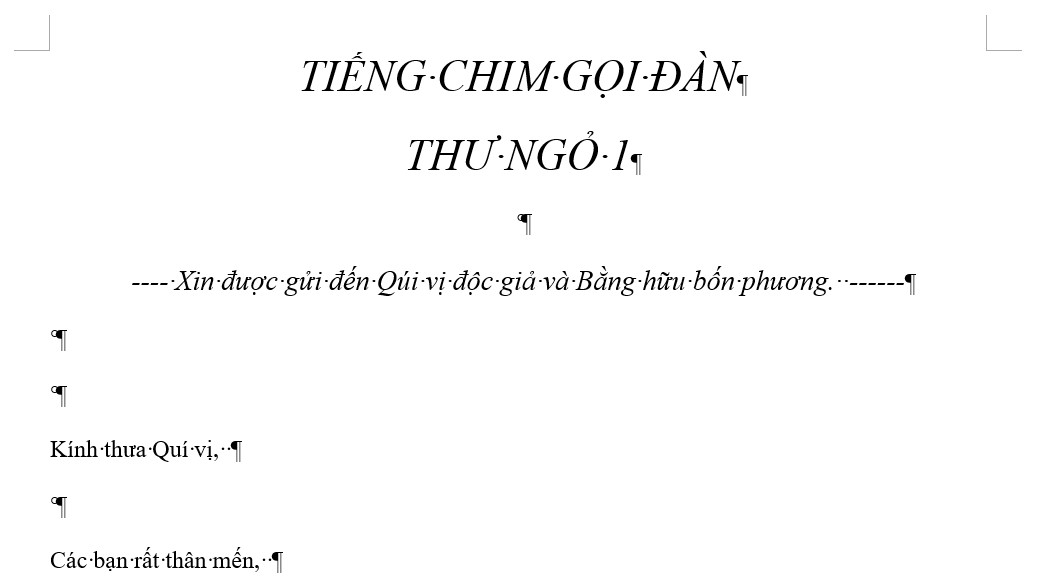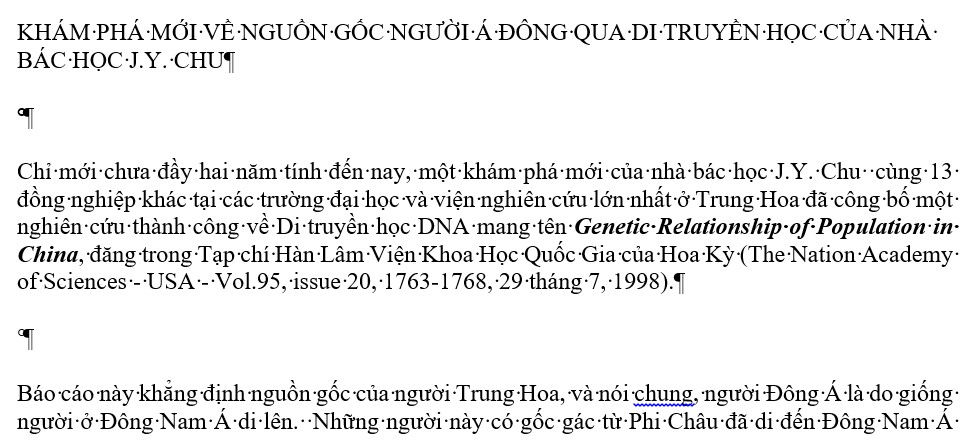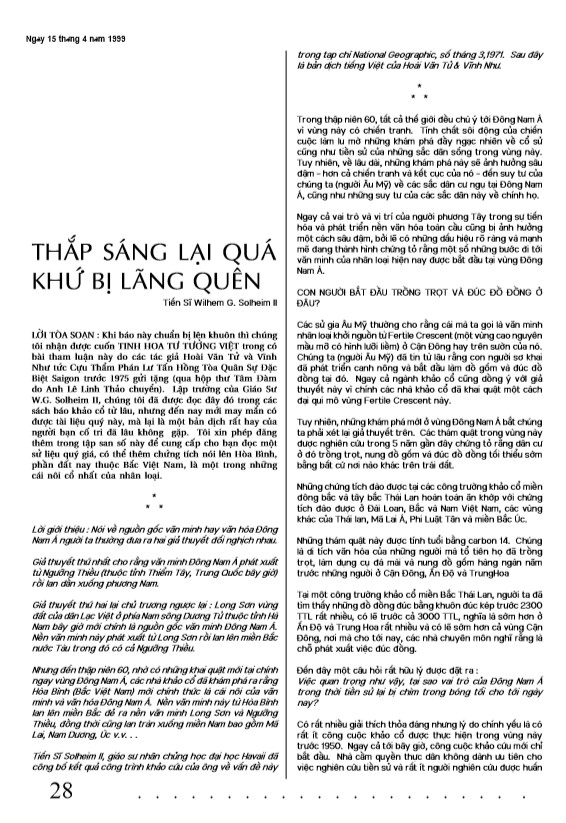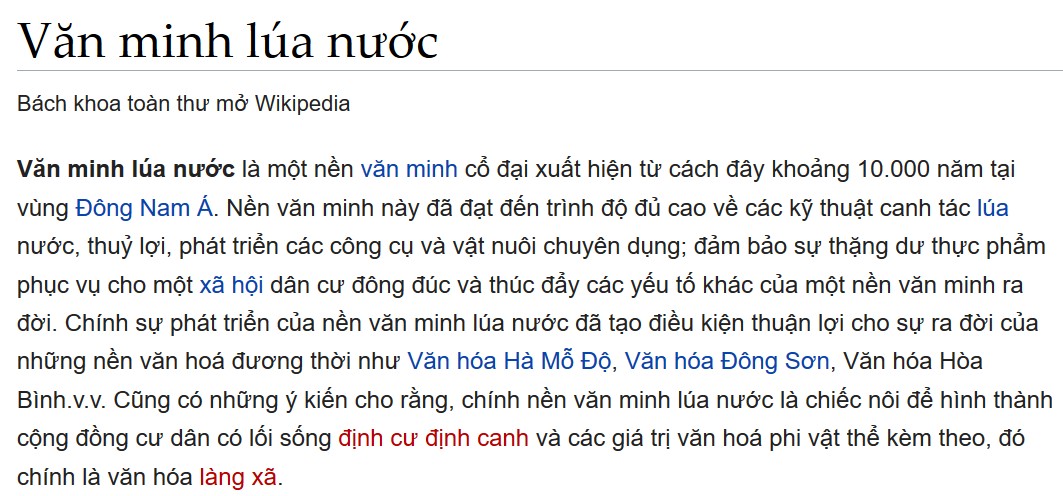There are certain ideas about early Vietnamese history that one can easily find expressed on the Internet, such as the ideas that 1) Hòa Bình was one the site of one of the earliest agricultural societies on the planet, and that wet rice was grown there as early as 10,000 years ago, and 2) people of this Hòa Bình culture brought their knowledge of rice cultivation northward and introduced it to the place that we now refer to as “China.”
As evidence for the first point, on web page after web page (and in numerous books) we find a statement that American archaeologist Wilhelm Solheim made in 1971 that “the first domestication of plants in the world was done by people of the Hoabinhian culture, somewhere in Southeast Asia. It would not surprise me if this had begun as early as 15,000 B.C.” [Wilhelm G. Solheim, “New Light on a Forgotten Past,” National Geographic Vol. 139, No. 3 (March 1971): 339.]
As evidence of the second statement, we find that a 1998 article by a group of genetic scientists led by J. Y. Chu is repeatedly cited. [J. Y. Chu, et al., “Genetic Relationship of Populations in China,” PNAS Vol. 95 (1998): 11763-11768.]
The person who introduced this perspective on the past and who first used the articles by Solheim and Chu to support his argument has now largely been forgotten. His name was Cung Đình Thanh, and although he passed away in 2006, the ideas that he introduced before he died are today widely discussed and reproduced on Vietnamese-language web pages.

Cung Đình Thanh was born in northern Vietnam in the 1930s. He obtained degrees in law and literature as well as a degree in administration and leadership from the University of Connecticut.
In 1954 he migrated to South Vietnam where he initially became a lawyer for the Court of Appeals and also taught at the National Institute for Administration. He then turned to educational and cultural issues, serving as a superintendent of some schools, editing a magazine called Cultural Development (Phát Triển Văn Hóa), and participating in various cultural organizations.
Cung Đình Thanh ceased to engage in all of these activities in 1975. In 1989 he migrated to Australia, and from his new home in New South Wales he gradually became active again. He established an organization called Vietnam International Culture Development Inc. that was dedicated to promoting the development of Vietnamese culture.
The main avenue for doing this was through the print and online publication of a journal called Thought (Tập San Tư Tưởng) that Cung Đình Thanh published from 1999 until his death in 2006.

Cung Đình Thanh was worried about Vietnam and the Vietnamese. He was afraid that Globalization would overwhelm the Vietnamese and he wished to provide them with a sense of strength that comes from knowing one’s culture and history.
To do that effectively, Cung Đình Thanh felt that it was necessary to write a new history of Vietnamese thought, and that in turn required rethinking and rewriting Vietnamese history, particularly the earliest periods of Vietnamese history – the time of prehistory.
In the first issue of Thought, Cung Đình Thanh called on Vietnamese overseas to help him by submitting articles and ideas. They did.
The second issue of Thought contained a Vietnamese translation of the article in which Solheim made the above statement.
The seventh issue of Thought introduced the ideas of J. Y. Chu and his colleagues, a group of genetic scientists that argued that in antiquity East Asia had been populated from the south, that is, from the area of Southeast Asia.

To greatly simplify Cung Đình Thanh’s writings, the gist was that he argued that (citing Solheim) rice was first cultivated by people of the Hòa Bình culture (văn hóa Hòa Bình) who then (following Chu) migrated northward into China and essentially established the foundation of China and Chinese culture.
This is a powerful idea, but it is ultimately not true as it is not supported by evidence. First, Solheim’s 1971 statement was a hypothesis, and it was never proven to be true. As archaeologist Miriam Stark noted in 2012 in an obituary for Solheim, “Subsequent field-based investigations— and analyses by his students and close associates—did not support [Solheim]’s claims that Southeast Asia had the earliest farming or plants.”
So there was no wet rice agriculture in Hòa Bình for the people there to carry northward.
There is also no genetic evidence for northward migrations at that time. While Chu and his colleagues only said that early humans arrived in the area of southern China/northern Southeast Asia around 60,000 years ago, subsequent studies have dated the northern migrations that led to the peopling of East Asia to around 30,000 years ago, long before Hòa Bình culture flourished, and even longer before people in Southeast Asia began to engage in agriculture.

Sometimes, however, what is true is not as important as what people want to believe is true, and it is obvious that there are plenty of Vietnamese who want to believe that wet rice was first cultivated in Hòa Bình and that people from there brought that technology northward into what is today “China.”
Cung Đình Thanh introduced those ideas in appealing and exciting ways, and that is why his model of the past can be found all over the Vietnamese Internet.
Establishment scholars, meanwhile, have not made an effective “counter argument.” That is why I call Cung Đình Thanh “the most influential Vietnamese historian of the 21st century (so far).”
It is not because he was a “good” historian, but because he was an “effective” historian in changing how people think.
And perhaps there is no better sign of his effectiveness than the fact that his name is not associated with the ideas that we can find repeated over and over on the Internet, such as on this Wikipedia page for “wet rice civilization.” This web page makes the claim that Southeast Asia is one of the earliest cradles of agriculture in the world and it cites a passage form Solheim’s 1971 article as evidence, a passage that was first published in translation in Cung Đình Thanh’s journal.

While Cung Đình Thanh’s ideas have spread widely, his journal has largely disappeared from view. . . but it can still be found. By looking up the URL for Thought (http://tutuong.hypermart.net/) in the Internet Archive Wayback Machine we can still access the journal and gain an understanding of what it is that Cung Đình Thanh was trying to achieve.
Finally, although Cung Đình Thanh’s interpretation of the past was not accurate, the intellectual effort that he made to rethink early Vietnamese history is admirable, and it points to an important moment in contemporary Vietnamese history as Vietnamese in both the diaspora and Vietnam have struggled to come to terms with the transformations that Globalization is bringing to their societies.


This Post Has 2 Comments
I read a paper recently on the genetics of Korean. The genetic of Koreans are said to be of Southern males (likely aboriginals Vietnamese or Taiwanese) and Northern female (North Asia in Siberia)
http://www.sciencemag.org/news/2017/02/ancient-women-found-russian-cave-were-close-relatives-today-s-indigenous-population
. If this is true, it actually happened before the age of agriculture and certainly before the peopling of East Asia came into being. On the other hand, another paper did a genome survey of various ethnicities around the world and found that none of these peoples are 100% pure, even the isolated tribes in Asia. Although this is something everyone may have expected, it’s strange that people still feel a special attachment to races and ethinicities.
https://www.nature.com/articles/s41598-017-01837-7
So at one extreme, races and origins mean a lot to people who studied these things from historical perspectives while at the other extreme, such as those scientists studying human genetics, races and origins are so vague. And historians are not yet familiar with this new kind of evidence from genetics and incoporate it into their research in a more meaningful way.
Thanks for the comments!!
Yea, the intermixing is really important. That is something that more recent genetic studies have pointed to (see below). Now people are talking about two migrations into East Asia from the south, and the latter group didn’t just replaced but intermixed with the people who were already there.
There are genetic studies that say the same thing about the southward migration of Austronesian-speakers into island Southeast Asia (much later, after say 4,000 BCE). They also intermixed with long-established populations.
Hong Shi, et al., “Y Chromosome Evidence of Earliest Modern Human Settlement in East Asia and Multiple Origins of Tibetan and Japanese Populations,” BMC Biology Vol. 6, Article No. 45 (2008): 1-10.
David Reich, et al., “Denisova Admixture and the First Modern Human Dispersals into Southeast Asia and Oceania,” The American Journal of Human Genetics Vol. 89, No. 4 (2011): 516-528.